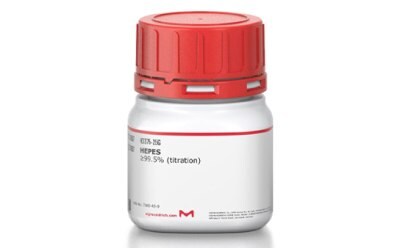HEPES Buffer

HEPES, also known as 2-[4-(2-hydroxyethyl)piperazin-1-yl]ethanesulfonic acid or 4-(2-Hydroxyethyl)piperazine-1-ethanesulfonic acid or N-[2-Hydroxyethyl]piperazine-N′-[2-ethanesulfonic acid], is an organic compound with zwitterionic properties. It is soluble in nature with a pKa value of 7.55, which makes it an effective buffer for maintaining physiological pH levels. HEPES has negligible metal ion binding abilities and is membrane impermeable. Moreover, it has a limited effect on biochemical reactions and has very low UV and visible absorbance.
Products
HEPES AS A BUFFER
HEPES is commonly used as a biological buffering agent in biochemical research that helps maintain a stable pH in aqueous solutions. It is effective as a buffer, especially in the pH range of 6.8 to 8.2. It can maintain a relatively constant pH even when small amounts of acid or base are added.
HEPES IN CELL CULTURE LINES
HEPES is utilized in human lymphocytoid cell line cultures as a storage medium. It is used in cell culture media as a buffer due to its CO2-independent nature, ensuring a stable pH value, even when handling media outside of an incubator. Additionally, HEPES is non-toxic to cells and does not get absorbed by them, making it suitable for maintaining cell viability during storage.
The addition of HEPES to the culture medium has been shown to enhance lysosomal-autophagic activity and increase inflammatory signaling in cells. Additionally, it is utilized for hydrogen-ion buffering in microalgal culture media, effective in stabilizing pH of both freshwater and artificial seawater media.
MOLECULAR BIOLOGY GRADE HEPES
HEPES Buffer is used to fabricate silver nanoparticles with excellent stability, which exhibit remarkable cytoprotective properties against HIV-1 infected cells. It is used to enhance protein separation efficiency on single polyacrylamide percentage gels, making it suitable for optimizing Western blotting procedures for protein analysis.
The presence of HEPES buffer at pH 8.0 resulted in a twofold increase in the reduction current of the Cu(II)-SA complex in the redox process of the copper(II)-salicylaldoxime complex [Cu(II)-SA]. HEPES buffer is used for in vitro degradation studies of magnesium-based materials. Its buffering capacity helps to maintain a consistently balanced pH level in the degradation solution.
HEPES IN EMBRYO CULTURE
HEPES-buffered medium is used to culture porcine embryos from the one-cell stage to blastocyst and is also used for the short-term storage of equine embryos.
HEPES AS A VERSATILE SOLUTION
HEPES Solution is frequently used in the production of nanomaterials, such as gold nanoparticles, silver nanoparticles, platinum group metal nanoparticles, and metal oxide nanostructures. Its role goes beyond serving as a reducing agent, it also serves as a stabilizer to prevent the aggregation of metal nanoparticles. This property makes HEPES an essential component in the synthesis of nanomaterials, as it supports the creation of stable and uniform nanostructures.
Additionally, HEPES Solution is used in the hydrolysis complexation of neptunium(IV) by forming stable complexes with neptunium(IV) and inhibiting further chemical transformations and aggregation. This stabilization is vital in nuclear waste management to maintain the integrity and containment of neptunium(IV) within the waste repository.
Para seguir leyendo, inicie sesión o cree una cuenta.
¿No tiene una cuenta?